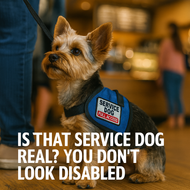Is that service dog real? You don't look disabled
Posted by WorkingServiceDog on May 1st 2024
Is that service dog real? You don't look disabled
Many service dog teams live with disabilities that are not immediately apparent. While some tasks—like guiding someone who is blind or assisting with mobility—are visible, others support conditions you cannot see. For people with invisible disabilities, skepticism and comments can add stress to daily life.
What Is an Invisible Disability?
Invisible disabilities include conditions that affect daily functioning without obvious outward signs. Examples range from hearing loss to diabetes, epilepsy, PTSD, and other neurological or medical conditions. Properly trained service dogs can perform specific tasks that mitigate these disabilities.
How Service Dogs Help with Invisible Disabilities
- Hearing Dogs alert to important sounds such as a fire alarm, a crying baby, or a doorbell—often by making contact and leading the handler toward the source.
- Diabetic Alert Dogs are trained to warn when blood sugar rises too high or drops too low so the handler can take action sooner.
- Seizure Response/Alert Dogs may respond at the onset of a seizure, providing safety support like prompting the handler to sit or moving them away from stairs.
ADA: What Businesses May Ask
When a disability is not obvious, staff may ask only two questions:
- Is the dog a service animal required because of a disability?
- What work or task has the dog been trained to perform?
They may not ask for medical records, demand special identification, require the task to be demonstrated, or inquire about the nature of the disability. A vest or ID is optional—not required by the ADA—but some teams use clear identification to reduce interruptions.
A Reminder for Everyone
The next time you see a person with a service dog who appears to be in good health, remember: not all disabilities are visible. Service dogs—large or small—perform critical tasks that give their handlers safety, independence, and confidence.
Looking for tools that make public access smoother? See our ADA information cards and service dog vests designed for clear, professional identification (optional under the ADA).

